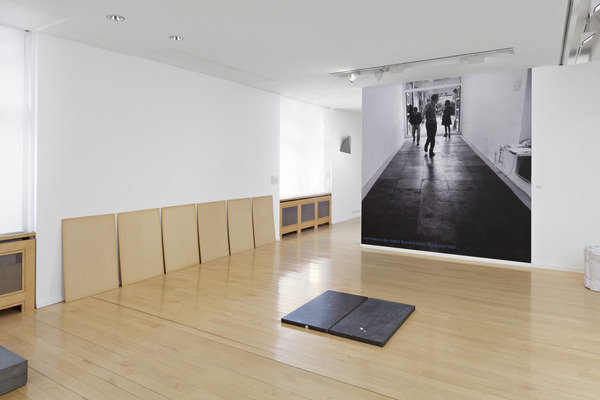Minimalism in Germany. The Sixties II
dal 30/3/2012 al 22/9/2012
Segnalato da
Hartmut Bohm
Erich Buchholz
Hanne Darboven
Hermann Glockner
Mathias Goeritz
Charlotte Posenenske
Peter Roehr
Ulrich Ruckriem
Eckhard Schene
Helmut Stromsky
Günther Uecker
Franz Erhard Walther
30/3/2012
Minimalism in Germany. The Sixties II
Daimler Contemporary, Berlin
Abstraction and Seriality, Zero, Concrete Tendencies and Sculpture as Action. About 40 works by 12 artists linked with the cities of Frankfurt, Dusseldorf, Hamburg, Stuttgart and Berlin. Grids, structures, combinations and serial formations are significant concepts in German Minimalism.

The ‘Minimalism in Germany. The Sixties’ exhibition is the second part of a series
addressing tendencies of Minimalism Art in Germany in the 1960s. The first event in
2010 dealt with important trends in reduced, abstract art in the 1960s, and the
current show concentrates on a small number of striking exponents who worked with
large-scale works, serial picture objects or action-oriented work concepts. You are
seeing about 40 works by 12 artists linked with the cities of Frankfurt, Düsseldorf,
Hamburg, Stuttgart and Berlin.
Hartmut Böhm, Erich Buchholz, Hanne Darboven, Hermann Glöckner, Mathias Goeritz,
Charlotte Posenenske, Peter Roehr, Ulrich Rückriem, Eckhard Schene, Helmut Stromsky,
Günther Uecker, Franz Erhard Walther.
In the early sixties in Germany, a new kind of Minimalism developed that was initially largely
independent from the developments in America at the time. This German Minimalism was in
many cases stimulated by, but also in conflict with, Concrete Art and the European Zero
avant-garde, which drew attention to itself from 1957 on, starting in Düsseldorf, with
unusually staged exhibitions and spectacular projects for public space.
The Düsseldorf Kunstakademie also played an important role in the transition to a specifically
German Minimalism from 1962 until around 1970. Joseph Beuys took over the chair of
monumental sculpture here in 1961; his sculptural vocabulary of reduced everyday forms—
crates, felt and iron panels, angle iron, display cases, simple shelves, fabric objects, metal
cubes—was interpreted from 1957 in the context of his work with actions, among other
things. In the sixties, it provided many of his students with a basis for examining minimalized
sculpture. At the same time, as a student of Karl Otto Götz, the young Franz Erhard Walther
developed his first proto-Minimalist objects starting in 1962, followed in 1964/65 by Imi
Knoebel, Imi Giese, and Blinky Palermo, students with Beuys in Düsseldorf. At the same time,
Hanne Darboven in Hamburg, a student of the Zero artist Almir Mavignier, Posenenske in
Offenbach (she studied with Willi Baumeister in Stuttgart 1951/52), and, outside academic
contexts, Peter Roehr in Frankfurt conceived their first attempts at Minimalist works.
Many post-war artists living in Germany felt that they were inheriting a ravaged artistic
landscape. Circa 1960, the center of current art developments shifted to New York. In the
mid-1960s, Darboven, Uecker, Posenenske, Rückriem and Walther travelled to New York to
exhibit their artwork there and to get into contact with other artists from this point
onwards, Minimalism in Germany was based on an interplay between European and American
movements and debates of the period.
What are the characteristics of ‘Minimalism in Germany in the 1960s’? Significant
characteristics that we can point to include the purist reduction to basic geometric forms that
can be seen in many artworks, the ordering of pictorial elements into mathematical and
geometric sequences, the minimizing and applying of permutations to a visual figural
language, anonymous materials and a depersonalized production process, translation of
quantity (serial elements) into an aesthetic quality and individual artistic elements and
decisions being negated, their authority suspended. Seriality as a factor of sculptural and
pictorial composition becomes ‘the grammar of the whole work’ (Sol LeWitt).
Grids, structures, combinations and serial formations are significant concepts in German
Minimalism. As Peter Roehr put it, the grid’s formal severity, clarity and simplicity doesn’t
create “a composition” it creates a structure that he describes as “a regular fabric with
identical objects”. Artists saw grid-shaped structures and serial sequences as aesthetic
models for anti-hierarchical and antiauthoritarian systems as the antithesis of composed,
hierarchically organized works.
Cultural and political philosophies could be said to have played a major role in the work of
many of the artists featured in the exhibition, in ways that vary widely depending on the
individual. Erich Buchholz sympathized with the Novembergruppe or ‘November Group’,
Hanne Darboven expounded a social critique through an aesthetically emancipated concept
of time, and Posenenske and Roehr’s serial artworks adopted an industrial aesthetic to
express a commitment to process-oriented, democratic art production.
The artists’ widely varied relationships with space are extremely significant. In 1922, in his
studio in Berlin, Erich Buchholz created a pictorial/sculptural spatial concept that was the
first of its kind in Germany, reconstructing it as a model in 1966. In 1966, Günther Uecker
created his Lichtregen, an artwork that invited viewers to walk through it and to make use of
it. Ulrich Rückriem and Helmut Stromsky explored grey areas between drawings and
sculptures, and Eckhard Schene and Franz Erhard Walther investigated spatial/perspectival
and action-based concepts of sculpture.
One of the fundamental driving forces behind Minimalism was the desire to replace the
ideologically contaminated material of the traditional art genre the pedestal, the bronze
cast, the canvas, the frame with industrially-produced mass products. This allowed the
desired de-individualization and objectification to be achieved even at the level of the
materials used often achieving a shock effect at the same time. Visitors to the early
exhibitions of Zero, Nouvelle Tendances and Minimalism were confronted with light and
metals (Uecker), rough-worked stone slab (Rückriem), plywood and PVC sheeting (Schene),
steel, cardboard and car body paint (Posenenske), folded paper, parcel paper and cotton (F.E.
Walther).
Image: Walther, Rückriem, André. Foto H.G.Gaul Berlin
Press contact:
Dr. Renate Wiehager Tel: 0711 / 17 - 92 695 Fax: 0711/ 17 - 94 141
Daimler Contemporary
Haus Huth Alte Potsdamer Straße 5 10785 Berlin
Opening hours: daily 11 a.m. - 6 p.m.
Admission free.



